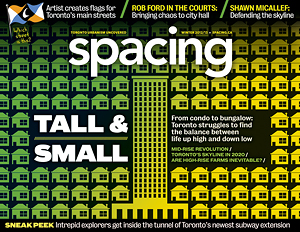 |
| Erie Terrace, looking south, 1916 (Toronto Archives, Fonds 1231, Item 2243) |
Sometime around 1899 saw the creation of a narrow dirt laneway called Erie Terrace. In 1923 it was renamed Craven Road. It is home to Toronto's smallest houses and longest wooden fence.
Saturday, August 24, 2013
Craven Road in Archive Photos
The five earliest photos of Craven Road in the City of Toronto Archives were taken on June 16, 1916, after the city decided to buy up a slice of Ashdale Avenue's backyards in order to widen the narrow, one-sided laneway then called Erie Terrace.
Ironically, these images show Erie Terrace's dirt road and wood-plank sidewalk, but reveal very little of its houses. The photos look south and a little west, focusing on the Ashdale side of the street, since they were taken to record the backyard property being expropriated to widen the street.
Friday, August 23, 2013
On the Fence
 |
| 1915 map of Toronto's annexed districts with dates (detail – click here for full map) |
The district of Midway became part of the City of Toronto in 1909. Not long afterward, narrow, unpaved Erie Terrace (as Craven Road was then called) became a headache for city politicians:
Friday, August 9, 2013
The Media Discover "Tiny Town"

"In the east end of Toronto, between Coxwell and Greenwood Avenues, there’s a place called 'Tiny Town.' The neighbourhood name might not show up on a map, but if you travel up and down Craven Road you’ll realize that the area is truly the epitome of modest living.
On Craven, you’ll find the largest collection of single houses under 500 square feet in the city. You’ll also find the longest wooden (and municipally maintained) fence in the city."Spacing's February 13, 2013 article "Tiny House Society of Craven Rd.", quoted above, is just one of several features on the street in the past few years.
Thursday, August 8, 2013
Fun with Math
Craven Road (formerly Erie Terrace) has been in the news a few times over the years.
The earliest mention I could find, thanks to the Toronto Star's addictive "Pages from the Past" archive, was in a real estate ad from 1906, offering land for as little as $2 per foot of street frontage:
A century and a bit later, on 22 February 2013, the same paper profiled a "House of the Week" at the bottom of the street, a brand-new, three-bedroom magazine-bait beauty selling for $889,000.
How do the prices compare?
The earliest mention I could find, thanks to the Toronto Star's addictive "Pages from the Past" archive, was in a real estate ad from 1906, offering land for as little as $2 per foot of street frontage:
 |
| (Toronto Star, May 5, 1906, p27) |
"ERIE TERRACE, Adjoining Reid Ave., $2.00 to $5.00 per foot. $5.00 cash, $5.00 per month." (Interesting to note that prices are half of those for plots on Reid Avenue (now Rhodes Avenue), only one block to the east.)
A century and a bit later, on 22 February 2013, the same paper profiled a "House of the Week" at the bottom of the street, a brand-new, three-bedroom magazine-bait beauty selling for $889,000.
How do the prices compare?
Wednesday, August 7, 2013
Origin Stories
In February 2013, the magazine Spacing published an admiring article titled "Tiny House Society of Craven Rd.", which included a theory on the origins of this quirky street:
And the idea that the narrow laneway was carved out of the backyards of Ashdale Avenue may be derived from the fact that when the City widened Erie Terrace in 1916, they did so by buying a chunk of the Ashdale residents' backyards.
But Erie Terrace was always its own road. The most detailed account of its history comes from the 2011 book Pigs, Flowers and Bricks: A History of Leslieville to 1920, an epic labour of love by Joanne Doucette:
Craven Road was once known as Erie Terrace, but before that, these lots that now house tiny buildings were attached to the back of properties on Ashdale Avenue — properties that used to extend back from the road over 140 feet. [Jack Ridout, a real estate agent whose family grew up on the road] says those who lived in the houses gave people materials to build places at the back of their lots. When there was a dispute over whose land belonged to whom around 1910, the City stepped in, expropriated the land, and created a tiny road between the houses on Ashdale and the rear lots.The mention of building materials probably springs from this 1907 ad in the Toronto Star:
 |
| "$10 A FOOT – Erie Terrace, 100 feet north of Gerrard street cars, no money down, lumber supplied to build. Davis, 75 Adelaide east." |
And the idea that the narrow laneway was carved out of the backyards of Ashdale Avenue may be derived from the fact that when the City widened Erie Terrace in 1916, they did so by buying a chunk of the Ashdale residents' backyards.
But Erie Terrace was always its own road. The most detailed account of its history comes from the 2011 book Pigs, Flowers and Bricks: A History of Leslieville to 1920, an epic labour of love by Joanne Doucette:
Subscribe to:
Posts (Atom)